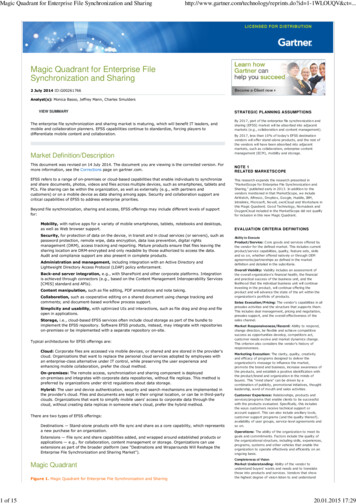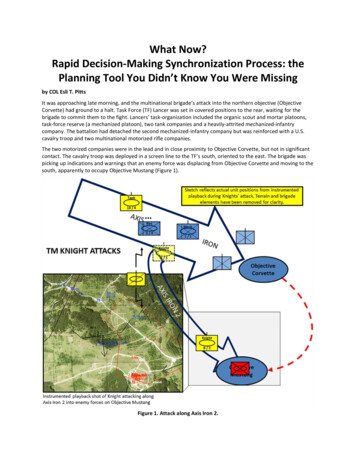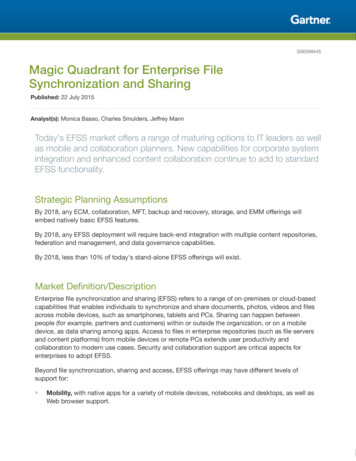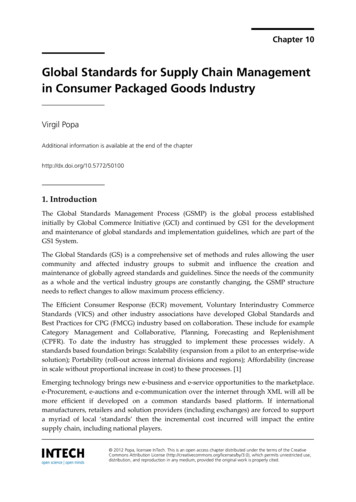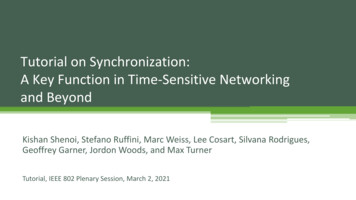
Transcription
Tutorial on Synchronization:A Key Function in Time-Sensitive Networkingand BeyondKishan Shenoi, Stefano Ruffini, Marc Weiss, Lee Cosart, Silvana Rodrigues,Geoffrey Garner, Jordon Woods, and Max TurnerTutorial, IEEE 802 Plenary Session, March 2, 2021
2IEEE 802 Plenary – Tutorial on Synchronization: A Key Function in Time-Sensitive Networking and Beyond3/2/2021AbstractSynchronization is crucial in many networking technologies, e.g., cellularnetworks, Time-Sensitive Networking (TSN) and in the communicationnetworks of various industry segments, e.g., telecommunication,industrial automation, etc.This joint tutorial of the Workshop on Synchronization and TimingSystems (WSTS) and the IEEE 802.1 Working Group introduces theprinciples of synchronization, synchronization techniques, e.g., theTelecom and the TSN profiles of the IEEE 1588 Precision Time Protocol(PTP), and application areas such as industrial automation andautomotive in-vehicle networks.
3IEEE 802 Plenary – Tutorial on Synchronization: A Key Function in Time-Sensitive Networking and Beyond3/2/2021Disclaimer This presentation should be considered as the personal views of thepresenters not as a formal position, explanation, or interpretation ofIEEE. Per IEEE-SA Standards Board Bylaws, August 2020“At lectures, symposia, seminars, or educational courses, an individualpresenting information on IEEE standards shall make it clear that his orher views should be considered the personal views of that individual ratherthan the formal position of IEEE.”
4IEEE 802 Plenary – Tutorial on Synchronization: A Key Function in Time-Sensitive Networking and Beyond3/2/2021
5IEEE 802 Plenary – Tutorial on Synchronization: A Key Function in Time-Sensitive Networking and Beyond3/2/2021Tutorial Outline Introduction to principles and use casesClock technologies, modeling, and requirementsIEEE 1588 PTP Telecom ProfilesQ&AIEEE 802.1AS PTP profile for TSNIEC/IEEE 60802 TSN Profile for Industrial AutomationIEEE P802.1DG TSN Profile for Automotive In-VehicleEthernet Communications Q&A
6IEEE 802 Plenary – Tutorial on Synchronization: A Key Function in Time-Sensitive Networking and Beyond3/2/2021Speakers (ATIS WSTS) Kishan Shenoi Stefano Ruffini Lee Cosart Marc Weiss Silvana Rodrigues
7IEEE 802 Plenary – Tutorial on Synchronization: A Key Function in Time-Sensitive Networking and Beyond3/2/2021Speakers’ biographiesKishan Shenoireceived his bachelors, masters, and doctorate degrees fromIIT-Delhi, Columbia University, and Stanford University, in 1972,1973, and 1977, respectively. He is active in Standardsdevelopment and active in the Steering Groups of WSTS andITSF. He is named on 54 patents and has several publicationsincluding two books, Digital Signal Processing inTelecommunications (1995) and Synchronization and Timing inTelecommunications (2009). Dr. Shenoi is currently CTO ofQulsar, developing fit-for-purpose solutions for timing andsynchronization.Stefano Ruffinijoined Ericsson in 1993. He is an expert at Ericsson Researchworking on synchronization and transport solutions. He iscurrently an active contributor to ITU-T SG15 Q13 (serving asrapporteur) and other relevant synchronization standardizationbodies, as well as serving as the chair of the InternationalTiming and Sync Forum (ITSF). Ruffini holds a M.Sc. intelecommunication engineering from Sapienza University ofRome, Italy.Marc Weissworked at NIST from 1979, specializing in time transfer techniques and statistics oftiming systems. Since January 2014 he is now a consultant on precision timingsystems. Marc founded and has led WSTS annually since 1992, which is now a sisterconference to the European version, the ITSF. In addition, Dr. Weiss led the NISTprogram to support GPS development from 1980 until his retirement in 2014. Hehas worked on and published Relativity issues as they relate to GPS and to primaryfrequency standards. He has also specialized in Time-Scale Algorithms. He receivedhis Ph.D. in Mathematical-Physics from the University of Colorado in 1981.Lee Cosartis a Research Engineer with Microchip. A graduate of Stanford University, his R&Dactivities have included measurement algorithms and mathematical analysis forwhich he holds several patents. He serves on, as chair, contributor and editor, theATIS and ITU-T committees responsible for network synchronizationstandardization. His TimeMonitor software is used to collect and analyzesynchronization and packet timing data and has been used in laboratories andnetworks throughout the world.Silvana Rodriguesworks for Huawei as a Senior Engineer. She holds an Electronic and ElectricalEngineering degree from University of Campinas, Brazil.She is currently the associate rapporteur and editor of several recommendations atITU-T SG15 Q13. She is a secretary of IEEE 1588 WG and participates in IEEE 802.1TSN WG.
8IEEE 802 Plenary – Tutorial on Synchronization: A Key Function in Time-Sensitive Networking and Beyond3/2/2021Speakers (IEEE 802.1) Geoffrey Garner Jordon Woods Max Turner
9IEEE 802 Plenary – Tutorial on Synchronization: A Key Function in Time-Sensitive Networking and Beyond3/2/2021Speakers’ biographiesGeoffrey Garner received his S.B. degree in Physics in 1976, S.M. degrees inNuclear Engineering and Mechanical Engineering in 1978, and Ph.D. in MechanicalEngineering in 1985, all from M.I.T. He was a Member of Technical Staff at AT&TBell Laboratories and then Lucent Technologies and became a DistinguishedMember of Technical Staff in 1999. Since 2003 he has been a consultant intelecommunications and networking, specializing in network timing, jitter,synchronization, and related mathematical and simulation analysis and standardsdevelopment. He has consulted for Huawei since 2008, and also for Samsung,Broadcom, Marvell, Hirschmann, Siemens, and Internet Photonics. He is active inIEEE 802.1, where he is editor of IEEE 802.1AS; ITU-T SG 15 Q13, where he iseditor of several Recommendations; and IEEE 1588. He is author or co-authorseveral articles, conference papers, and patents, and primary author of over 300standards contributions.Jordon Woods is a strategic technologist for Analog Devices Industrial EthernetTechnology Group (IET). IET enables seamless and secure connection of customerproducts across the entire landscape of Industrial IoT. Woods has 35 years ofexperience in the semiconductor industry. He is familiar with a variety of Ethernetbased Industrial protocols including Profinet, EtherNet/IP, as well as IEEE TSNstandards. He is also a voting member of the IEEE 802 working group defining newEthernet standards for Time Sensitive Networks and the editor of the IEC/IEEE60802 Time-Sensitive Networking Profile for Industrial Automation.Max Turner holds a Diploma degree in Physics from the University of Ulm. Hejoined BMW in Munich at the end of 2002 where he worked on MOST and FlexRayphysical layer specifications. From 2005 to 2008 Max was working at the BMWTechnology Office in Palo Alto, California where he focussed on DSRC based V2xcommunication around IEEE802.11P and IEEE1609. After his return to Munich hestarted the introduction of Ethernet into Autosar (SocketAdaptor) and became partof the team developing the Diagnostics over IP (ISO13400) specification. Max waspart of the team introducing Ethernet (e.g. SOME/IP and AVB) into BMW vehiclesand was active in IEEE and AVnu to foster automotive Ethernet adaptations. Maxspent two years at Jaguar Land Rover in Gaydon UK, where he worked on vehiclenetwork architectures focussed on automated driving, before joining Ethernovia inDec. 2019, where he serves as Automotive Network Architecture Lead, bringingOEM experience and latest semiconductor hardware design together.
10IEEE 802 Plenary – Tutorial on Synchronization: A Key Function in Time-Sensitive Networking and Beyond3/2/2021Stefano Ruffini and Kishan Shenoistefano.ruffini@ericsson.com, kshenoi@qulsar.com
11IEEE 802 Plenary – Tutorial on Synchronization: A Key Function in Time-Sensitive Networking and Beyond3/2/2021Kishan Shenoi
12IEEE 802 Plenary – Tutorial on Synchronization: A Key Function in Time-Sensitive Networking and Beyond3/2/2021Frequency and Time A clock is a frequency device based on physicsProvides “ticks” at precise intervalse.g., Atomic Clocks, Quartz, MEMS, etc. Electronic systems count “ticks” for time interval“Time-Clock”provides thetime elapsedsince the “start” Time is steered to chosen reference, generally UTC UTC: Defines the “start” plus corrections for astronomy
13IEEE 802 Plenary – Tutorial on Synchronization: A Key Function in Time-Sensitive Networking and Beyond3/2/2021Alignment in Frequency, Phase & TimeAligning (or Synchronization) of two Time Clocksimplies:Frequency B Frequency A10MHzTick GenerationSyntonizationPhase B Phase ARoll-over instant10,000,000CounterSeconds B Seconds AElapsed timeequal1Hz“Time”: Same formatting convention, time-zone, etc.Clock is ems count“ticks” for timeintervalTime is acombination of asignal (event) anda label (timevalue)10MHzSecondsCounterPhase alignment(roll-over coincident)Seconds roll-over for an “Event”Time alignment(equal # of seconds)10,000,000Counter1HzSecondsCounterTime alignment (“local time”)Time alignment (UTC)“Time”Clock A“Time”Difference time-errorClock B
14IEEE 802 Plenary – Tutorial on Synchronization: A Key Function in Time-Sensitive Networking and Beyond3/2/2021Time scales such as UTC Time is always measured against a reference clock. For example: Some “clocks” are weighted averages of clocks, so-called paper clocks GPS has its own time scale called GPS time, which is usually kept within 10ns of UTC, but is only required to be within 1 microsecond! GPS also broadcasts a version of UTC based on the US Naval Observatoryreal-time UTC, UTC(USNO) UTC is a post-processed average of clocks from around the world Any real time UTC is a prediction for a given lab UTC(NIST) in US, UTC(OP) in France, UTC(NPL) in UK, etc.
15IEEE 802 Plenary – Tutorial on Synchronization: A Key Function in Time-Sensitive Networking and BeyondThe Generation of Coordinated Universal Time, UTC3/2/2021Any Real-Time UTC is only a Prediction,A PLL with a one-month delay (There is a provisional “rapid” UTCpublished tability:Labs provideclock datadelayBIPM collectsdata from labs,computes andoutputs TAIand UTCLabs Output UTC(lab)Based on Predictions ofUTC
16IEEE 802 Plenary – Tutorial on Synchronization: A Key Function in Time-Sensitive Networking and Beyond3/2/2021Time and Timescales Time is an artificial construct. Choose an origin (“epoch”) that people can agree on Count the number of seconds (milliseconds /microseconds /etc.) from the origin. Define suitable units such as seconds and minutes and hours and days and so on to express the countfrom the origin Time Interval (e.g., 1 s) is based on a physical property of the Cesium atom.TimescaleEpochRelationshipLeap SecondsOtherTAIJan 1, 1958Based on SI secondNoContinuousUTCUT‐1GPSLoran ‐CLocalJan 1, 1972Jan 1, 1958Jan 6, 1980Jan 1, 1958Jan 1, 1972TAI-UTC 37secEarth’s rotationTAI – GPS 19secUTC 27 secTAI-UTC usDiscontinuousDiscontinuous,Based on Time zoneoffsetPTPNTPJan 1, 1970Jan 1, 1900TAI – PTP us” timescale allows for jumps related to leap seconds
17IEEE 802 Plenary – Tutorial on Synchronization: A Key Function in Time-Sensitive Networking and Beyond3/2/2021Stefano Ruffini
18IEEE 802 Plenary – Tutorial on Synchronization: A Key Function in Time-Sensitive Networking and Beyond3/2/2021Use cases requiring synchronization Synchronization (time and/or Frequency)is a key component in various contexts Traditionally required in “TDM” transportnetworks (SONET, SDH) Required by various Applications, thatmay themselves put requirements on thetransport network (of any technology) Cellular networksIndustrial AutomationSmart GridPositioning Time Sync often in the microsecond; Frequency sync in parts per billion (ppb)Cellular network synchronizationSynchronization for end applicationsSmart industryTime-sensitive networkingPositioningSmart power grids
19IEEE 802 Plenary – Tutorial on Synchronization: A Key Function in Time-Sensitive Networking and BeyondUse cases requiring synchronization: 5G Coordinated Transmission reception (e.g., CarrierAggregation): max tolerated relative time difference at the UE (MRTD)MRTD TAE ΔTprop. Time Division Duplex: Synchronization to avoid UL/DL interferences3/2/2021
20IEEE 802 Plenary – Tutorial on Synchronization: A Key Function in Time-Sensitive Networking and Beyond3/2/2021Use cases requiring synchronization: 5G for TSN 5G to support Industrial Automationapplications Need to meet relevant requirements(to align e.g., production lines,production cells, ormachines/functional units) IEEE, Use Cases IEC/IEEE 60802From 3GPP TS 23‐501:5G system is modeled as IEEE Std 802.1AS complianttime aware system for supporting TSN time synchronization3GPP TS 22.104 The synchronicity budget for the 5G system within the global time domain shall not exceed 900 ns
21IEEE 802 Plenary – Tutorial on Synchronization: A Key Function in Time-Sensitive Networking and Beyond3/2/2021Synchronization methods in ITU-T G.8271 Time Sync distributed via PTP Distributed PRTCRadio distributed PRTC, e.g., GNSS ordistribution via cablesRadio distributed PRTC, e.g., GNSS ordistribution via cablesRxPRTC limitsPRTC limitsPacket timingdistribution ationRxPacket timingdistribution RxPRTC limitsEndapplicationPRTC limitsEndEndEndapplication application applicationPRTC limitsEndapplicationG.8271-Y.1366(12) F01Time or phase synchronization distribution via cableTime or phase synchronization distribution via radioEndapplicationEndapplicationG.8271-Y.1366(12) F03From ITU‐T G.8271: Figure 3Example of time synchronization distributed via packet based methodsT-BCTime or phase synchronization distribution via cableTime or phase synchronization distribution via radioFrom ITU‐T G.8271: Figure 1 – Example of a distributed PRTC synchronization network
22IEEE 802 Plenary – Tutorial on Synchronization: A Key Function in Time-Sensitive Networking and Beyond3/2/2021PRCPhysical layersynchronizationnetwork(1) Upon failure of an upstream T-BC in thechain, PTP messages on the PTP primarysynchronization path are no longer present.The T-BC informs the other PTP clocks inthe chain downstream that the reference is nolonger PRTC traceable. PTP clocks then executethe BMCA to determine a new onization plicationT-BC(EEC)T-TSCPRCPhysical layersynchronizationnetworkPRTC(2) During the rearrangement, the physicallayer frequency signal is used to locallymaintain the phase/time reference in theend application clock. The PTP messagesreceived during this period are not used.(3) Once a new PTP backup synchronizationpath has been determined by the BMCA, thePTP messages received are again used tosynchronize the PTP clocks.G.8275-Y.1369(13) F12T-GMT-BC(EEC)T-BC(EEC)Physical layer frequency signal (e.g., synchronous Ethernet)Phase/time distribution interface (e.g., 1PPS)PTP messagesT-BC(EEC) ITU-T G.8275 specifies theGeneral Architecture forpacket-based time syncincluding relatedrequirements Aspects addressed are forinstance: Protection scenarios Interworking betweenPTP profilesFrom G.8275 Figure 12 –Illustration of protection scenario 2(switching to a backup reference with physical layer frequency synchronization support)
23IEEE 802 Plenary – Tutorial on Synchronization: A Key Function in Time-Sensitive Networking and Beyond3/2/2021Distribution of Timing – Traditional Telecom NetworksITU-T G.803 and G.8261 describe thegeneral architecture for physical-layerdistribution of (frequency) syncincluding related requirements forSDH/SONET and SynchronousEthernet scenarios. Traditional Telecom Networks distribute timing in a hierarchical manner A “most accurate clock” originates timing and timing references are delivered over thetransmission medium allowing the generation of clocks that are aligned with the source Similar principles apply to frequency distribution (aka physical layer timing), as shownabove, as well as time distribution (aka packet layer timing such as PTP) shown earlier Synchronized clocks utilize PLL methods (aka servo methods) for disciplining controlledoscillators and mitigating additive clock noise (jitter/wander/packet-delay-variation)
24IEEE 802 Plenary – Tutorial on Synchronization: A Key Function in Time-Sensitive Networking and Beyond3/2/2021Kishan Shenoi and Marc Weisskshenoi@qulsar.com, marcweissconsulting@gmail.com
25IEEE 802 Plenary – Tutorial on Synchronization: A Key Function in Time-Sensitive Networking and Beyond3/2/2021Kishan Shenoi
26IEEE 802 Plenary – Tutorial on Synchronization: A Key Function in Time-Sensitive Networking and Beyond3/2/2021Sync is Fundamentally Synchronization is fundamentally concerned with the delay of a timing signalbetween clocks Time sync requires accounting for the delay: the better you know the delay, thebetter the accuracy of synchronization Frequency sync is done over an interval and requires only that the delay remainthe same between successive transmissionsTiming SignalSourceClockSubordinateClockDelay 1Delay 2Clock 1Medium adds “clock noise”Clock 2
27IEEE 802 Plenary – Tutorial on Synchronization: A Key Function in Time-Sensitive Networking and Beyond3/2/2021Synchronization Techniques A timing signal is a signal that inherently includes the clock properties of the source, allowing thedestination to extract a timing reference Using this timing reference the destination can construct a (near) replica of the source clock. Example: the transmit waveform used to deliver digital information can provide a frequencyreference.
28IEEE 802 Plenary – Tutorial on Synchronization: A Key Function in Time-Sensitive Networking and Beyond3/2/2021Transfer of frequency – Timing Signal (one-way) Example: Pulsed transmission provides an edge for each “1” Clock Recovery “fills” in the edges recovered clock transmit clock Phase is unknown because of unknown transmission delay (one-way suitable for frequencybut not phase/time transfer) Jitter in recovered clock can be filtered out (lowpass filter function of a PLL) Example: Manchester encoding of data provides a signal transition every bit-timeTransmit ClockBit Time (Symbol Time)Manchester Code(mid-bit transition)1 ( ve)0 (-ve)0 (-ve)1 ( ve)1 ( ve)1 ( ve)Recovered Clock Transmit Clock Jitter
29IEEE 802 Plenary – Tutorial on Synchronization: A Key Function in Time-Sensitive Networking and BeyondTransfer of Time (e.g. Precision Time Protocol: IEEE 1588TM) Transfer of time and/or phaserequires two-way exchange todetermine round-trip delay Utilizes time-stamped packets toprovide a timing reference Transfer quality affected by variabletransmission delay and asymmetry PTP (aka IEEE 1588TM): Master sends Sync Message (with T1)Slave time-stamps arrival (T2)Slave sends Delay Request; time-stampsdeparture (T3)Master time-stamps arrival (T4)Master sends Delay Response (with T4)1.2.3.3/2/2021Round Trip Delay (RTD) (T4 T1) (T2 T3)Assuming symmetric delays upstream and downstream, OneWay Delay (OWD) (1/2) RTDSlave Offset from Master, OFM (1/2)[(T4 T1) – (T3 T2)]
30IEEE 802 Plenary – Tutorial on Synchronization: A Key Function in Time-Sensitive Networking and Beyond3/2/2021DSP view of a locked loop (Time Domain)Oscillator noisequantization noise𝐻 𝑧𝛾· 1𝛽1 𝑧𝑇𝐻 𝑧𝑧1Phase difference or time errorQUpdate interval TS is equivalent tosampling intervalOscillator also adds noise { (n)}composed of (all “low-frequency” effects): Random component (typically white-FM)Effect of agingEffect of temperatureProportional IntegralDCOPHY LAYER LOOPOutput signalPTP Layer Loop is mathematicallysimilar with time error developedfrom time-stamped packets (“OFM”)
31IEEE 802 Plenary – Tutorial on Synchronization: A Key Function in Time-Sensitive Networking and Beyond3/2/2021ITU-T Recommendations for Equipment Clocks Key items addressed related to timing performance: Input noise limit (jitter & wander) toleranceOutput noise (wander) limit, usually as masks for MTIE and TDEVMaximum output time errorBandwidth of PLL or noise transfer characteristicsHoldover behaviorTransient behavior (e.g., reference switching)Maximum frequency departureNoise generation – output noise when reference inputs are pristine
32IEEE 802 Plenary – Tutorial on Synchronization: A Key Function in Time-Sensitive Networking and Beyond3/2/2021ITU-T Recommendations for Equipment Clocks Principal Recommendations related to timing performance G.8272 : Primary Reference Time Clock (PRTC) G.8272.1 : Enhanced Primary Reference Time Clock (ePRTC) G.8273.2 : Telecom Boundary Clock (T-BC) and Telecom Slave Clock (T-TSC) assuming full on-path timingsupport G.8273.3 : Telecom Transparent Clocks G.8273.4 : Telecom Boundary Clock (T-BC) and Telecom Slave Clock (T-TSC) assuming partial on-path timingsupport G.8263 : Packet-based Equipment Clock (frequency) (assumes no on-path timing support) G.8266 : Telecom grandmaster clocks for frequency synchronization G.8262 : Synchronous Equipment Slave Clock (aka “SEC” and/or “EEC”) G.8262.1 : Enhanced Synchronous Equipment Slave Clock (aka “eSEC” or “eEEC”)
33IEEE 802 Plenary – Tutorial on Synchronization: A Key Function in Time-Sensitive Networking and Beyond3/2/2021Marc Weiss
34IEEE 802 Plenary – Tutorial on Synchronization: A Key Function in Time-Sensitive Networking and Beyond3/2/2021Block Diagram of Atomic ClockPassive StandardAtomicResponseAtomicResonatorFrequency (e.g. for Cs 9,192,631,770Hz )FrequencyControlFrequencySynthesis5 MHzSlave (Qz)OscillatorAmp.OutputFrequencyDivider Output(Counter) Time Ticks
35IEEE 802 Plenary – Tutorial on Synchronization: A Key Function in Time-Sensitive Networking and Beyond3/2/2021Types of Commercial Atomic Clocks Cesium (Cs) thermal beam standard Rubidium (Rb) cell standard Small size, low cost Hydrogen (H) maser Best stability at 1 to 10 days (short-termstability) Expensive several 100K Chip Scale Atomic Clock (CSAC) Very small size, low power Note that new generations of clocks areunder development!Timing Error @ 1 day ( s) Best long-term frequency ACRb010Cs beamBetter-210H-maser-410-610-410-210010210Power Consumption (W)410
36IEEE 802 Plenary – Tutorial on Synchronization: A Key Function in Time-Sensitive Networking and Beyond3/2/2021Oscillator Stability(floor)Aging (/day) initialto ultimateApplicationsCheap Quartz,TCXO10-6 10-11 10-1110-7 to 10-8Wristwatch, computer, cellphone, householdclock/appliance, Hi-quality Quartz,OCXO10-8 10-12 10-1210-9 to 10-11Network sync, test equipment,radar, comms, nav, Rb Oscillator 10-9 10-11 10-1310-11 to 10-13Wireless comms infrastructure,lab equipment, GPS, Cesium Beam 10-13 10-11 10-14nilTimekeeping, Navigation, GPS,Science, Wireline commsinfrastructure, Hydrogen Maser 10-11 10-13 10-1510-15 to 10-16Timekeeping, Radio astronomy,Science,
37IEEE 802 Plenary – Tutorial on Synchronization: A Key Function in Time-Sensitive Networking and Beyond3/2/2021Oscillator Comparison (continued)TechnologySizeWeightPowerWorld MarketCostCheap Quartz,TCXO 1 cm3 10 g 10 mW 109s/year 1sHi-qualityQuartz, OCXO 50 cm3 500 g 10 W 10Ks/year 100sRb Oscillator 200 cm3 500 g 10 W 10Ks/year 1000sCesium Beam 30,000 cm3 20 kg 50 W 100s/year 10KsHydrogen Maser 1 m3 200 kg 100 W 10s/year 100Ks
38IEEE 802 Plenary – Tutorial on Synchronization: A Key Function in Time-Sensitive Networking and Beyond3/2/2021Holding a Microsecond after Loss of Sync(circa 2020)TemperatureOvenChip ScaleCompensated lator(CSAC)(TCXO)(OCXO)Range of 10 minutes – 1 – 12 hours 3-15 hourstimes to hold1 houramicrosecondCost Range 5-20 50-500 llator8 hours – 3 10-300 daysdays 500-1500 20K - 50K
39IEEE 802 Plenary – Tutorial on Synchronization: A Key Function in Time-Sensitive Networking and Beyond3/2/2021Lee Cosart and Silvana RodriguesLee.Cosart@microchip.com , silvana.rodrigues@huawei.com
40IEEE 802 Plenary – Tutorial on Synchronization: A Key Function in Time-Sensitive Networking and Beyond3/2/2021Lee Cosart
41IEEE 802 Plenary – Tutorial on Synchronization: A Key Function in Time-Sensitive Networking and Beyond3/2/2021Contents Profile conceptITU-T Q13/15 Telecom Profiles overviewITU-T G.8275.1 ProfileITU-T G.8275.2 Profile
42IEEE 802 Plenary – Tutorial on Synchronization: A Key Function in Time-Sensitive Networking and Beyond3/2/2021The concept of Profile—A profile is a subset of required options, prohibited options, and the ranges anddefaults of configurable attributes—e.g. for Telecom: update rate, unicast/multicast, etc.—PTP profiles are created to allow organizations to specify selections of attributevalues and optional features of PTP that, when using the same transportprotocol, inter‐works and achieve a performance that meets the requirementsof a particular application—Telecom Profiles: ITU-T G.8265.1, G.8275.1, G.8275.2—Other (non-Telecom) profiles:—IEEE C37.238 (Standard Profile for Use of IEEE 1588 Precision Time Protocol in Power SystemApplications,)—IEEE 802.1AS (Timing and Synchronization for Time-Sensitive Applications in Bridged Local AreaNetworks)
43IEEE 802 Plenary – Tutorial on Synchronization: A Key Function in Time-Sensitive Networking and Beyond3/2/2021ITU-T Q13/15 Profiles, Clocks and Migration of the NetworkSDH CkSDH CkSDH CkPRCITU-T G.813, G.811, G.812 specifies clocks used in the SDH NetworkPRCITU-T G.8262 specifies synchronous clocks, including Synchronous Ethernet (SyncE), thatare compatible with SDH clocks defined in G.813 and G.812SDH networkEx.: GSM͠SyncEEx.: GSM͠SDH CkSyncESynchronous Ethernet networkSDH networkT-GMEx.: GSMNetwork without syncE/PTPSyncEPTPEx.: LTE, 5GLocal TimeReference(e.g. GNSS)Ex.: LTE, 5GEx.: Indoorsmall cellSyncEPTPSyncEPTPPRTCNetwork with T-BC/T-TC in all nodesNetwork without syncE/PTPSmall network without syncE/PTPPRTCITU-T G.8265.1 profile was targeted for applications that need frequency synchronizationsuitable for earlier deployment scenarios that only needed frequency when there was no syncEand no IEEE 1588 support in the equipment. ITU-T G.8263 specifies the end clock.ITU-T G.8275.1 profile was targeted for applications that need accurate phase/timesynchronization required due to increasing need for time sync in Telecom. It was enabled byupgrades done in the network to support T-BCs and/or T-TCs in every node of the network.Enhanced synchronous clocks (e.g., eSyncE) are specified in G.8262.1 for tighter clock accuracy.ITU-T G.8273.2 specifies T-BC/T-TSC and G.8273.3 specifies T-TC.ITU-T G.8275.2 profile was targeted for applications that need accurate phase/timesynchronization, but the network is not able to provide full time support (no T-BCs/T-TCs) dueto legacy equipment or in the case of leased line. ITU-T G.8273.4 specifies the clocks.PRTCAppendix III of ITU-T G.8275 provides generic interworking function used to connectnetwork segments that are running different profiles
44IEEE 802 Plenary – Tutorial on Synchronization: A Key Function in Time-Sensitive Networking and Beyond3/2/2021Silvana Rodrigues
45 IEEE 802 Plenary – Tutorial on Synchronization: A Key Function in Time-Sensitive Networking and Beyond3/2/2021Time/phase Synchronization Architecture with full timingsupport from NetworkFigure 1 from ITU-T G.8275BC – Boundary ClockT-BC – Telecom Boundary ClockTC – Transparent ClockT-TC – Telecom Transparent ClockT-TSC – Telecom Slave ClockPRTC – Primary reference time clock General network topology for time/phase distribution from a packet master clock PRTC to a synchronousEquipment clock The synchronization flow is from the master to end equipment nodes, although the timing messages will flow inboth directions Several ITU-T Recommendations has been developed to support accurate phase/time synchronization G.8275 (Architecture), G.8275.1 (PTP telecom profile), G.8271 (Network Requirements), G.8271.1 (Network limits), G.8272(PRTC), G.8272.1 (enhanced PRTC), G.8273 (Framework of clocks), G.8273.2 (T-BC and T-TSC), G.8273.3 (T-TC )
46IEEE 802 Plenary – Tutorial on Synchronization: A Key Function in Time-Sensitive Networking and Beyond3/2/2021ITU-T G.8271.1 PTP network architecture G.8273.2 and G.8273.3 define several classes of T-BCs and T-TCs to beused in G.8271.1 architecture. Reference chains with class A and B havebeen fully studied for telecom backhaul For shorter chain N 12 (uses T-BC/T-TC class A)For longer chain N 22 (uses T-BC/T-TC class B) G.8275.1 profile is used in this architecture 1.5 µs Guidelines for network dimensioning for telecom fronthaul Fronthaul assumes the use of T-BC Class C (enhanced SynchronousEthernet required) or T-BC class B Short clock chain (M 4 with class C and M 1 for class B)260 nsPRC Primary Reference ClockPRTC Primary Reference Time ClockT-GM Telecom Grand MasterT-BC Telecom Boundary ClockT-TC Telecom Transparent ClockT-TSC – Telecom Slave ClockT‐BC/T‐TCcTEdTE(MTIE)max TE dTE (High‐Passfiltered)Class A (with SyncE) /-50 ns40 ns100 ns70 nsClass B (with SyncE) /-20 ns40 ns70 ns70 nsClass C (with eSyncE) /-10 ns10 ns30 ns (T-BC)Under Study
Synchronization is crucial in many networking technologies, e.g., cellular networks, Time-Sensitive Networking (TSN) and in the communication networks of various industry segments, e.g., telecommunication, industrial automation, etc. This joi
